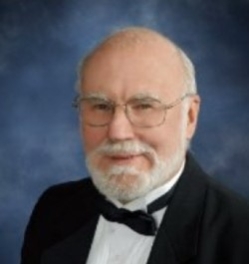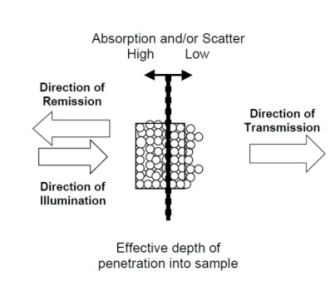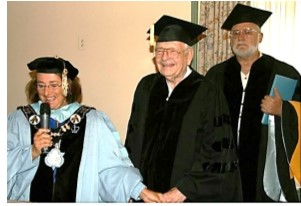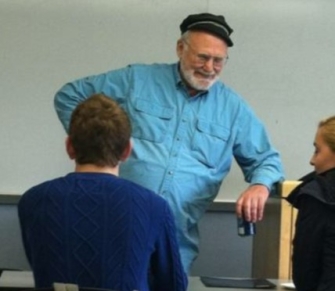
Karl Norris and the Representative Layer Theory
Contribution from Donald J Dahm
It is no secret that those of us who knew Karl love talking about our interactions with him. We often measured the importance of our own contributions by his opinion of them. It is impossible for me to separate our interactions involving science from those that were personal. Everything he did was permeated with thoughts of near infrared spectroscopy close by. He described himself as addicted, and I said that I too was hooked, and predicted that I would never leave the field.
It’s been about 35 years since the publication of Phil and Karl’s Near-Infrared Technology in the Agricultural and Food Industries. I myself am now an old-timer, even though I am clearly not one of the founding members of the field. (I was told by a beautiful, young French woman at NIR2013 that I was the third oldest person at the conference. Probably not one of her better pickup lines!) Perhaps I could tell you how I became involved in the field of NIR and eventually with the publication of the second edition of said Handbook. But the main point of all this will be to describe how Karl Norris contributed to the development of Representative Layer Theory, which came to pass after theoretical work in the area of Diffuse Reflectance had languished for many years.
I entered the field of NIR spectroscopy by becoming an employee of NIRSystems. I wanted to once again be a practicing scientist after a lucrative career ending in being jettisoned from an upper management position at age 50. I had been trained in a highly mathematical field as an X-ray crystallographer. That field had passed me by, and the chemometric nature of NIR analysis was attractive. I knew little about the field, but was anxious to learn. A few weeks into the job, I overheard someone complaining about a software problem in an adjacent room. When he left, I asked “Who is that old man?”. “That’s Karl Norris.” The way it was said kept me from asking what I wanted to know: “Who the hell is Karl Norris?”
Well, as far as I could tell, he was the only guy in the place who really paid attention to the science of things, so I began to visit him in his office. (Still didn’t have a clue who Karl Norris really was. Just trying to soak up some understanding.) I would ask him what he was doing and why. (I was just asking questions, the kind a research director asks when he reviews projects.) Sometimes he would say something like: “That’s a great idea; I’ll give it a try”. (It's possible he was just being nice, but I think that my questions sparked ideas in him that he incorrectly attributed to me.) At some point, I got brave enough to ask a question that would expose my lack of knowledge.
I had just collected data on two samples. One was on a powder; the other on pellets extruded from that powder. The pellets gave a very strong {log(1/R)} signal; the powder had a pattern barely discernible from the background. I reasoned (not correctly) that the samples were the same except the pellets had a larger void area in the sample, and since all I was doing was reducing the amount of sample per volume, I would reduce the α and σ proportionately, and the ratio should remain constant, implying no change in absorbance. I wanted to know why the absorbance metric was so strongly affected.
Karl explained to me that it was due to a pathlength difference. That was my first exposure to what I’ve come to call his Intuitive Model. (I’ve included an illustration of the model. The ideas were Karl’s; the drawing is mine.) His idea was that as either absorption or scatter went down, the sample penetration would go up, yielding a longer pathlength. In this case, both the absorption and scatter went down due to concentration, but scatter also went down due to the fusion of particles during the extrusion process.

While that was impressive enough for me, he went on to say that he trusted no theories that did not include pathlength, and that I should be reading the theory in the “Ag and Food Handbook” instead of the Handbook of NIR Spectroscopy, and he loaned me his copy. There I was exposed for the first time to The Physics of Near-InfraRed Reflectance chapter by Gerry Birth and Harry Hecht. While there was plenty of math there, there were pictures and charts that appealed to the eye and intuition rather than the brain.I was a changed man..
In 1996; I attended my first IDRC. It was here that I first realized what a god-like figure Karl was to so many people. Karl gave two talks:
Diffuse Reflectance Spectroscopy: 1) Where Are We and What Needs to be Done?
2) How Should We Treat the Data?
At the first talk, which was the keynote talk, Karl opined that the theory was lagging behind the chemometrics and there was a need to catch it up. In the discussion following the second talk, I wrote out the general form of the mathematical solution. I also gave a poster, which did not disclose the math, that explained why the {α/σ} thing was incorrect. (Gerry Birth seemed to be the only person who understood the significance of what I was saying, but unfortunately he was no longer comfortable carrying on a discussion with anyone but his son.)
After hearing in confidence where the math stood, Karl persuaded Don Webster (NIRSystems president), in exchange for any patent rights which might exist, to give me a grant to work with Karl in the NIRSystems facility to develop the mathematics into a usable theory.
After a period of “thrusting around”, we sat down one day and Karl described all the generalizations he could recall from the data he had collected over the years. (He seemed to remember every experiment he had ever done.) Next we developed a list of questions which the theory should explain. (For example: Why are small particles “over-represented” in the absorbance spectra?). … Then Karl gave me what I blasphemously referred to as “the great commission”. He wanted to understand the theory well enough to answer these questions before he retired. When I finally came up with the Representative Layer Theory, Karl was bothered by the fact that the layer was a different thickness at different places. He thought I needed to describe how these layers fit together to fill space. In a spirited discussion, I took a bottle of particles, repeatedly shook it and gingerly put it down (I’m trying to avoid the word “slammed”) on the table. I said: “Each time I shake it, the bottle has a different void fraction, which is what contributes to re-pack variation in spectra. Aside from that, the representative layer is identical in each. I don't have to tell you how the layers fit together in each; it’s enough to know that God was able to do it.” I knew I was winning the argument when his scowl was replaced by a smile. I almost always curtailed our arguments, because if I wasn’t sure of my position, I would quickly yield to his vast experience and knowledge before a real argument started.
One area where I should have argued more was on the issue of whether there is a single scattering coefficient for a sample, or whether the scattering coefficient changed with absorption. I spent weeks, without success trying to extract that single coefficient from a set of data Karl had collected from a set of plastic sheets. Karl then got a paper from Thorsten Burger (“Diffuse Reflectance and Transmittance Spectroscopy for the Quantitative Determination of Scattering and Absorption Coefficients in Quantitative Powder Analysis”) which agreed with my position. Karl said he owed me an apology, but I refused to hear it. Just told him I learned a lot that I needed to know in the process of chasing his idea. Eventually, Karl came to believe that the theory was in pretty good shape, and suggested it be me that would update Gerry Birth’s and Harry Hecht’s Physics chapter for Phil’s and his handbook. (Just so you know, Karl very much let Phil do the project’s heavy lifting.) The only guidance I got from Phil was to make damn sure that the color photos from the first edition remain in the chapter. As we were working, we became convinced that the best single measurement to make on a powder was on a thin sample in transflectance.
This bothered Karl because he had frequently gone on record saying that the best sample for reflectance measurements was an “infinitely thick” one. He asked me to develop the mathematics to relate the apparent absorption coefficient observed in transflectance to the one that would be observed in transmission. With Kevin’s help, we did so, and published it: Donald J. Dahm, Kevin D. Dahm, Karl H. Norris; Obtaining Material Absorption Properties from Remission Spectra of Directly Illuminated Layered Samples.
I don’t remember much about the paper, probably because I was between jobs and wives while it was being written, flitting around the world (literally). Karl never wanted his name on anything unless he had collected data for the study, and then he always wanted his name last. (I know my name appears first, but credit this one to Karl and Kevin.)
In 2005, Karl was the session chair and presenter at the EAS Award for Outstanding Achievements in NIR / Vibrational Spectroscopy for our work.
In 2006 I was able to arrange for Karl to receive an Honorary Doctorate from Wilson College It was given at the IDRC banquet. Karl (and most of the audience) didn’t know it was going to happen. Susan Foulk pulled Karl out into the hallway, and dressed him in his robe. I just said: “This is for real. Smile all you want to, but don’t laugh.” That was the only time I ever heard ‘Pomp and Circumstance’ played on guitars.

Dean of Wilson College, Karl and Don, IDRC 2006.
Some things Karl told me that you may not have heard: He had begun college hoping to become a designer of agricultural machinery. But WWII intervened. … He met his wife though letters she was writing to various soldiers. … He got into NIR because, when he suggested at an inter- departmental meeting that it may be ideal for a problem at hand, the analytical chemists pretty much ignored his suggestion. ... He made sure that contracts for the building of an instrument were given to different groups so as to create competition. ... He always kept his personal copies of software separate from that of NIRSystems, and complained when they labeled something that departed from his method as “Norris Regression”. … He wouldn't be leaving the USA anymore because of his wife's health. … His memory of past experiments was fading.
The last time we argued was in print on the NIR Discussion Forum (I kind of forgot we were “in public”). He wrote in response to my criticism (about something that turned out to be more of a misstatement than a misconception): “I hope those who follow this discussion are aware that Don and I have been co-workers and good friends for a long time. I think we make a good combination with Don focusing on the theory, while I focus on the experimental data. We don't always agree and we don't hesitate to say so.”

I was honored to be numbered among Karl’s many friends.
Captioned (by a student) “I don’t always wear this hat but when I do I’m high and ….talking about dwarfs”.
I assure you its only caffeine!
Don




